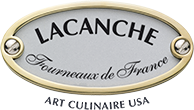Discover Bourgogne (Burgundy)
Stretching from the vast plain of Bresse to the Auxerrois vineyards, Burgundy is not only a place remarkable for its wines, gracious hospitality and foods, but is also rich in historical places of interest. As a special destination for Art Culinaire staff and clientele, we highly recommend a visit to Burgundy anytime. Due to weather and tourist considerations, early Spring and late Fall remain our favorite times to assimilate into the local culture and sample seasonal cuisine.
Lacanche GM Jean Jacques Augagneur muses about life in Burgundy, its traditions and culture.
Chambertin
The village of Gevrey-Chambertin – with its 3,258 inhabitants in the Hautes Cotes de Nuits – is famous for its fortress castle. Its vineyards are among the most prestigious in the world, several having been awarded Grand Cru (literally, “great vineyard”) status, like Charmes-Chambertin and Latricières-Chambertin.
Cluny
Famous in the whole world for its abbey, the town of Cluny in Saône et Loire has about 3,500 inhabitants. Founded in 909 by the Duke of Aquitaine, the abbey had successively and in less than two centuries, built three Roman churches. The last of them, the St. Paul-St. Pierre was the largest in the Christian world before the construction of St. Pierre in Rome. At the end of the 11th century, Cluny was the biggest spiritual center of the Christian world, and at its apogee 10,000 monks and 1,200 monasteries in Europe depended on its authority. The abbey was demolished after the French Revolution and its destruction lasted until 1823. Today, only Eau Bénite church tower and the Horloge tower are remaining. The Arts and Métiers School, the Ochier Museum of Art and Archeology, the Hôtel-Dieu and its apothecary are also in the medieval city of Cluny.
Cormatin
Cormatin is a small village in the department of Saône et Loire, with only 452 inhabitants. Its famous castle was built during the Renaissance and is the greatest remaining example of Louis XIII living quarters in France. There is also a Bicycle Museum located in the village.
Fontenay
The Abbey of Fontenay is famous all over the world, and although founded in 1118 by St. Bernard, it is still intact and looks like it did when it was first built. Isolated in the middle of the woods, it had everything the monks needed. This Roman arts masterpiece rigorously adheres to the Order of Cîteaux Rule. The Abbey belongs to “the world Heritage” of UNESCO.
Sully
Opulent Chateau de Sully stands in the small village of Sully, between Beaune and Autun, in Saône et Loire. In this private castle, built during the renaissance, live the Duke and Duchess of Magenta, direct descendants of the Dukes of Burgundy. This majestic edifice was General MacMahon’s birthplace. He was the President of the French Republic between 1873 and 1879, and was the first Duke of Magenta.
Volnay
Formerly the summer residence of the Dukes of Burgundy, the site of Volnay is one of the most typical villages of Côtes de Beaune. This small picturesque village has kept its traditional character, conserving and respecting the very ancient brotherhood of Saint Cyr. The Volnay vineyards, with only Pinot Noir grapes, produce AOC and 1ers Crus.
Vougeot
The famous Clos du Vougeot castle, headquarters of the brotherhood of the Chevaliers du Tastevin, stand in the small village of Vougeot in the Hautes Côtes de Nuits. The Clos Vougeot vineyard is the largest vineyard of the 1ers Crus in the world, with its over 120 acres located all around the castle and its 12th century cellar. The property is co-owned by 85 different owners.
